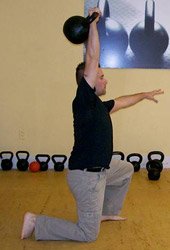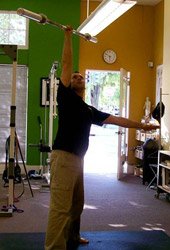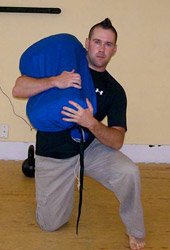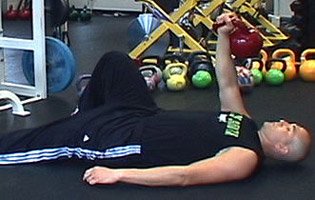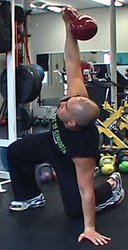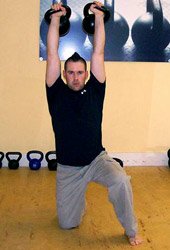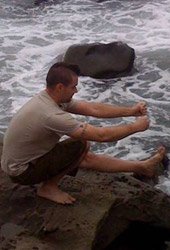"What the h*ll is a Turkish Get-Up?" Most likely that is your first question. The TGU can be a serious wakeup call if you have been plugging away in the gym, maxing out on the Smith Machine and the leg press, but haven't developed any real functional strength. I file it under the same category as the deadlift.
There's no way around it, if you can deadlift a reasonable amount of weight you are strong. If not, back to the drawing board with you.
Some people tell me that the deadlift, overhead press, etc. aren't the kind of training they do. Well, exactly what kind of training do you do? I train to get stronger. I understand that some prefer to build size and aren't concerned about strength. If that's your bag then that's fine, but why not try to do both?
As I said, I file the TGU and the deadlift under the same heading: How is the TGU like the deadlift?
The Turkish Get-Up is a highly functional movement that requires all the muscles of the body working together in order to accomplish the task.
Anyone worth their salt will understand that deadlifting properly and pulling respectable numbers is going to put some meat on your bones. I believe the TGU will accomplish the same thing when properly programmed into your training.
Of course the other side to this is nutrition. We all need to have proper nutritional practices, but if you're a smaller guy like myself, getting big means eating big. This doesn't mean just slamming down everything in sight, but taking in more quality calories is essential.
In addition to the above benefits, if you are doing heavy powerlifting style training, there is a good chance that you are losing some range of motion as you generally sacrifice some mobility in order to gain stability. The Get-Up can help to restore some of that, particularly in the shoulder girdle, which has a tendency to get tight in most people, regardless of profession or activity level.
As I said before, some prefer to pursue the aesthetics and aren't concerned with functional strength. If that is your choice, you want to ensure that you are not sacrificing your health.
I'll often hear people say things such as: "Don't do any cardio while bulking." Well, you're going to bulk your heart straight into a coffin with you wrapped around it if you pursue that type of thinking. Movements like this will promote healthy joints, keep your posture correct, and your primal movement patterns intact, as well as get your heart beating faster and healthier.
Many of the things we do with functional training (particularly kettlebells) flies in the face of conventional wisdom. It is important to learn the rules before you break them, but equally important to think outside the box in order to achieve the best results for yourself and your clients if you are a trainer.
Prior to the popularity of bodybuilding in the 60's and 70's, the average person didn't know what the bench press was. This isn't because the bench press is no good, but prior to this era most men were training for functional strength that could be used in daily tasks.
They would have seen no reason to train lying down. So before the measure of strength became: "How much can you bench?" you were more likely to hear: "How much can you military press?" or "Bent Press?"
In a time before not only the internet, but before wide availability of texts on fitness, young men who wanted to become wrestlers or strongmen had to go down to the local gymnasium in order to learn from the old timers. These were hard men with lines in their faces and hands like leather.
Instead of large, breast like pecs they had broad shoulders and backs forged of steel. Often they would teach the young man the Turkish Get-Up and tell him not to come back until he was able to do it with 100 lbs. At that point they would teach him some new exercises. These weren't commercial gyms where you paid your dues to the tune of twenty-five or fifty bucks a month. In this time you paid your dues with hard work and dedication.
You may think 100 lbs. is a near impossible feat, but I assure you it is not. At 160 lbs. I put up 100 lbs. in the Get-Up. Adam Glass puts up 165 lbs., last I checked. His goal is 250 lbs. You can read more about his training here.
What does that 100 lbs. get you, aside from the right to move forward with your training? It insures that you have GPP (General Physical Preparedness) and do not have weak points, such as men with giant upper bodies and tiny chicken legs, or well-defined abs but no obliques to speak of, and therefore no rotational control.
Many people remark on the six packs MMA fighters have, but rarely do I hear them comment on the powerful obliques that keep them from getting thrown to the canvas, and are just as visible. I don't know about you, but I am thoroughly unimpressed by men with six pack abs, and wispy little waists.
So how do you do it?
The Turkish Get-Up is simply the mechanically correct method of coming from a position lying on the floor, to standing while supporting a weight locked out overhead. I will cover a few different methods of doing this.
1 With A Kettlebell
This method requires a great degree of shoulder flexibility and stability as well as wrist strength. You may not have these attributes when you begin, but the movement is eminently scaleable and will help you develop them.
I have seen many people rehabilitate very restricted range of motion in the shoulder girdle via the TGU. The kettlebell method also has a strong effect on strengthening your grip.
Nine out of ten men who walk in my door have a weak grip. Not because they are weak, but because they have just never trained it. Of particular import to you boxers, mixed martial artists, and street fighters is that the stronger your grip, the harder you hit. Your fist is like a rock, so the stronger it is, the harder you can make that rock.
2 With A Barbell
This requires a greater degree of balance, and not as much wrist strength. It is also useful in that you can graduate the weight at smaller increments. Many of you will not have a kettlebell, and very possibly no interest in kettlebell training. Using the barbell or dumbbell allows you to start working with this great exercise.
3 With A Sandbag
Utilizing a sandbag for this movement puts a greater emphasis on core strength and stability and can help to build strong rotational control.
How To Perform The Get-Up
For the purposes of this article I am assuming you will be starting with a lighter dumbbell when first learning the movement, and progressing up to a barbell or kettlebell.
When first learning the movement it is best to practice with either bodyweight or a very light object. Just because you may be strong, don't think you can just pick up a heavy weight and start doing this, as you may be setting yourself up for injury.
- Lying on the floor, safely move the implement into a locked out position straight up with your right hand. Your shoulder should be tight in the socket. Your right leg will be cocked, your right foot alongside your left knee.
- Pushing off your right foot, roll onto your left hip and up onto your left elbow.
- Push up onto your left hand.
- Holding yourself up on your left hand and right foot, bring yourself up off the ground, and thread your left leg back to a kneeling position. You are now left knee on the floor, right foot on the floor, and implement locked out overhead in your right hand.
As stated, your arm should be locked out. You will be stronger in this position than in a flexed position, where the muscles would be doing all the work. This is a whole body exercise and particularly a shoulder developer, it is not meant to tire your arms out. - From the kneeling position take in a deep breath, tighten up, and lunge forward to a standing position.
- Reverse the process to come back down to the floor.
Remember that a Turkish Get-Up is not complete until you return to the start position. The descent is one of the hardest parts, which is why I see so many people on YouTube doing a Get-Up to the standing position, and then dropping the weight to take a break to flex for the camera. Their Turkish Get-Ups do not count.
Helpful Tips
- Watch the implement at all times.
- Do not look away, or you may quickly find yourself losing said implement. This will also help to keep your shoulder girdle aligned.
- Be ready to throw your implement away.
- Whether this be a kettlebell, barbell, or dumbbell, be prepared to 'ditch' it if you start to lose control. I have dropped a 40 kilo kettlebell on my chest, and a barbell loaded with 100 lbs. on my hip. It is no fun.
- Prepare your workspace.
- This ties in with tip number two. Make sure you aren't going to throw your barbell onto some hapless gym goer doing crunches next to you.
- Adapt your form to what works best for you, within reason.
- I have instructed only one variation of the get up, which is the lunge style. There are other versions including an overhead squat style, where you draw your forward leg back only far enough to get into the bottom position of a squat, and then simply stand up. This will require more shoulder and posterior chain flexibility.
- If you decide to train for a heavy get-up you will find little tricks along the way to maximize your results. There is no 'cheating' when it comes to the TGU, so long as you follow the basic rules. How you get up is between you and the implement.
- Keep your wrist straight!
- Do not allow the implement to pull your wrist into hyperextension. If you allow this to happen you will experience wrist pain over time, and there is a good chance you will lose that kettlebell or barbell.
- Each time you move into a new position think to yourself, "Could I sit here for a minute?" If the answer is 'no', fix your position.
- Gymnasts refer to it as 'joint stacking'. For instance, when you are threading your leg through, you should be running a straight line from the hand supporting you on the floor, to the hand holding the implement overhead. This is a strong position. If you are tilted, clearly it is not strong.
- Keep the reps low.
- In the beginning keep it at five reps per side or less. With a kettlebell you may do a five minute cycle where you switch hands each rep, but this will still probably only end up being five reps per side. You may bring it up to ten minutes as you become stronger and develop solid technique.
- Get rid of the running shoes.
- More often than I care to count I walk through gyms and see people doing weight training in cushioned running shoes, or even see people doing kettlebells in running shoes. Hey, I used to do it before I knew better.
- Any cushion in the sole of your shoe will disrupt your ability to balance and become stable, which in turn will affect how much weight you can put up and the efficiency of your movements. If you have been squatting or deadlifting in cushioned shoes, take them off or get some Converse Chuck Taylors. There's a good chance your numbers will shoot up.
Tying It Up
As I stated previously, this is relatively easy to plug into your existing programming to add additional challenges and benefits to your training. You may also use this to point you in a new direction in your training, perhaps toward gaining more strength-oriented results.

